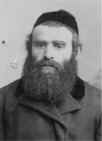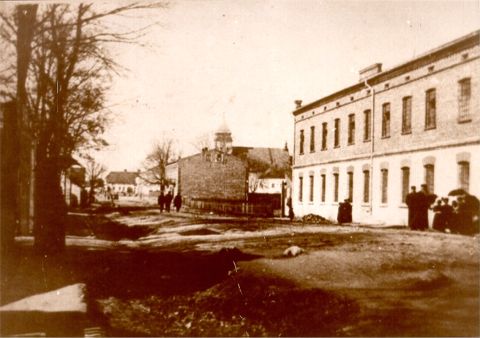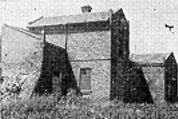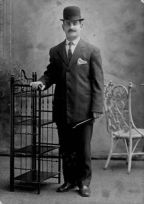![]()
History of Jewish Belchatow
Jewish Population:
In 1764, only seven Jews were listed as living in Belchatow. Jews at first did not settle there due to its poor economy.The chronicles of a Franciscan monk around 1790 contains the first reference to a Jew of Belchatow ("the Jew Dawid"). In 1809 the registers of non-Christian citizens of Belchatow were established. By 1820, according to some sources, Jews, attracted by the textile industry, constituted more than 50% of the population. According to Mojzesz Feinkind, in his History of the Jews in Piotrkow and its Surroundings (1930), the wealthy Polish Catholic Leon Kaczkowski invited rich Jews to Belchatow and gave them land for their houses (and for a cemetery and a synagogue). In 1834 he opened a Catholic elementary school, which was also attended by Jewish children. The school had 172 pupils of three religions in five classes.
After the January Uprising of 1863, many Jews came to Belchatow, as their settlements in some other parts of the Russian Empire was forbidden. In 1864, the Franciscan monastery was closed, and the area around the Church (today's Narutowicz Square) was offered for sale. Many lots were bought by Jews (who made up 80% of the population), which led to a concentration of Jewish houses in the area of Narutowicz Square and Pabianicka Street.
By 1921 Jews comprised 59% of the population (3,688). In 1939, when they numbered almost 6,000, Hitler declared Belchatow a Jewish town.
|
|
Employment:
In the early to mid-1800s, Jews were employed as tailors, materials makers, subcontractors, soap makers, a wheat grinder, and workers in other manufacturing shops. Among the clothiers and sellers of cloth (in an official document in 1825), the names of several Jews (Samuel Felker, David Rozen, Szaja Birnbaum, and the Herszel Weiss and Jankiel Birnbaum Company) appear. This pattern remained until the mid-19th century when some Jews also became lenders.
In 1842, among nine textile journeymen, there were 3 Jews, 1 Pole, and 5 Germans. Jews became traders of cotton, and weaving mills were founded by many Jews. By 1867, Jews owned 13 of 16 small textile factories in Belchatow, one woolen firm and twelve cotton firms. Although the Germans of the town monopolized the production of cloth, the Jews possessed 80% of the cotton industry.
As the 19th century neared its end, the majority of the working Jews in Belchatow were in the textile business, manufacturing material. Belchatow had 32 factories at that time. In 1895, two large weaving factories were owned by Mendel Tusk and Lejzor Warszawski, who also owned a steam sawmill. In 1899, Chaim Tusk, a former trader of cloth, took ownership of the big factory and shop, employing between 35-70 workers (depending on the season), who were paid 15 kopeks per day (enough to buy 2 kg of bread). Other smaller factories were owned by Szai Fajwin (150 workers), Aron Warszawski and Jankiel Guberman (100 workers each). Altogether about 1,000 workers were employed in the nine largest textile factories.
| Click here for an view of typical 19th century Jewish Life in Belchatow, as described in the Memoirs of Morris Samuel Bornstein (edited by Roger Spitzer). This account provides a picture of a single family's experiences. See the section on his grandfather, Moshe "the Sefeaner" (1814-1888), a tanner and observant Jew, for a description of the marketplace, the work week, and the Sabbath. The section on his father, Joseph, who left for Warsaw to seek his fortune but returned during the Polish revolt against Russian rule, affords a view of the introduction of the weaving industry to Belchatow, a typical arranged marriage, and move to Lodz for a better life. See the story of his brother Barnett, who was forced to work when he was a child, for an account of his arrival in America in 1892, when, after a "tragic marriage," he left Belchatow, like many others, for fortune and freedom. |
Click here to read a translation of "Belchatow in the Year 1898" -- a chapter by P. Wald in the Belchatow Yizkor Book on the Yizkor Book Project site hosted by JewishGen.
View of unpaved Kosciuszki Street, with Jewish residents congregated in front of building, in 1913. Click here to read a translation (by Martin Bornstein, the author's grand-nephew) of "Belchatow -- During the First World War" -- a teenager's view of life in Belchatow during that time, by Yankel Yosef (Jacobo) Zylberszac, from the Journal for the Double Anniversary for the 40 Years of the Mutual Aid Society and the 20th Year of the Cooperative “Superacion” [“Overcoming”], a Yiddish/Spanish publication written in 1980 in Buenos Aires, Argentina, on the Yizkor Book Project site hosted by JewishGen. Click here to read a translation of "Relief Activities During the First World War" -- a chapter about the foundation of the cheap tea hall and the cheap kitchen in Belchatow in February 1915, when the more than 800 Jewish families in Belchatow were largely without work as a result of the war, and the subsequent fundraising and relief activities through July 1917, in the Belchatow Yizkor Book on the Yizkor Book Project site hosted by JewishGen. In 1925 Belchatow was declared a city rather than being merely an industrial settlement from an administrative point of view. Although many workers were employed in automated factories, the Jewish workers still tended to work in weaving and home-hand-made and ready-made clothing. They sold their wares at local and neighboring markets and fairs. Click here for a translation of the section on Belchatow from the 1929 Polish Business Directory Project of JRI-Poland in cooperation with JewishGen. It includes a list of Businesses and Industries ranging from doctor and banker to midwife and stall-operator at the weekly marketplace, each of which is followed with a list of names of the proprietors and merchants (Jewish and Christian). Click here for a translation of J. M. Pukacz's reminiscences of Chaim-David Kaufman's Shoemaker Shop and home, including anecdotes about the daily life of poor Jewish Belchatowers, seeing the silent movies at the cinema, baking matzoth, and other events. Click
here for a translation of an article published in
the Polish Slowo Zydowskie [Jewish Voice], in 2001. It discusses
Jewish publications in the
Belchatow/Piotrkow Trybulnalski area. The Jewish newspapers in Belchatow
were published in Piotrkow Trybunalski, often by Belchatowers who worked there. The oldest Jewish print shop in Piotrkow was
the Belchatowski Company, established in about 1850 by Fajwel Belchatowski and Chaim
Frenkel. | |
Religious Life:Until 1820, Belchatow's Jews belonged to the Kahal, or Kehilla (Jewish Community), of Piotrkow Trybunalski. In 1821, they decided to choose their own leadership. Jews from over 20 surrounding villages and the town of Grocholice joined this new Kahal. From 1846 to 1854 the Kahal increased, as did its budget, from 270 rubels to 370 rubels. | |
| A small wooden framed shul (synagogue) and a cemetery existed in 1824 on Kempfinowka Street. In frequent disrepair, the shul was renovatd in 1893 but finally collapsed completely in 1897. In its place a new synagogue made of stone was built on Ewangelicka Street, later named 19th January Street, in 1893. [After the Holocaust, the synagogue became a sports center and was eventually torn down in 1956. The Talmud Torah (Yeshiva) was used as an apartment building.]
|
|
The Synagogue (and Talmud Torah in back) | |
Click here for a translation of "The Synagogue" from a 1996 magazine article by Boguslaw Dziedzic, including a description of the synagogue and its history and his personal recollections of the tearing down of the Synagogue in the spring of 1956. Click here for the results of the Kahal Election of 1901, including a list of the 12 candidates for election to the Kahal (Board of the Jewish Community) of Belchatow and the votes they received from the 191 Jewish men residing in Belchatow's synagogue district with the right to vote.
| |
| In 1827,Reb David Shlomo WEISS served the Belchatow Jewish community as rabbi and dayan. His son, Reb Mordechai WEISS, inherited the position after his father's death in 1831. |
| In 1832, Reb Moshe BRESSLER from the Kotsk Chassidic group was was chosen as dayan. In 1834 he was appointed the Rabbi for Belchatow. Friction existed among the various Chassidic movements in town and, in 1840 when Rabbi Bressler's opponents were in charge of the Kehilla, increased to the point of mutual slander to the authorities. Rabbi Bressler threatened to excommunicate his opponents and spent Yom Kippur in protest in nearby Grocholice. His supporters prevailed, and he retained his position. |
| After Rabbi Bressler's death in 1860, Rabbi KOHNSZTAM from the wealthy Gur (or Ger, from Gora Kalwarya) Chassidim presided until his death in late 1889. |
| Reb Moshe Eliahu BIRENBAUM was chosen as the next Rabbi by a coalition of the Alexander Chassidim along with support of the poor Jews of Belchatow, to the chagrin of the Gur Chassidim. Their unrelenting accusations and threats forced him to leave his post a few years later and to move to Lodz, where he headed the Mizrachi movement and made aliyah (emigration to Israel) in 1926. |
| In 1892-93 the Gur Chassidic movement was successful in getting Reb Shmuel Shlomo BRAUN, the Rabbi of Lukow and a religious conservative, elected the next Rabbi in Belchatow. He established and ran a Yeshiva in town. In 1903, on the eve of the 1905 revolution, he resigned and left Belchatow. |
|
| Once again, a coalition of the Alexander Chassidic movement and the workers elected a new Rabbi, Reb Zemach (Cejmach) David TORNHEIM, who served as Rabbi of Belchatow from 1903 until his death in 1938. The grandson of the patriarch of the Wolborz dynasty (Rabbi Issachar Dov-Ber Hacohen Tornheim, 1770-1831), Rabbi Tornheim supported the Mizrachi (an Orthodox Zionist movement) in the internal Kehilla debate and opposed Agudat Israel (a non-Zionist Orthodox political movement), which was supported by the Gur Chassidim, who maintained their own dayan and shochet during the inter-war years. |  | ||
| Rabbi Tornheim (1904, age 39) |
| After Rabbi Tornheim's death in 1938, Reb Shmuel Yehoshua Horowicz, from the Gur Chassidic movement, became the next and the last Rabbi of Belchatow. (Reb Shmuel Yehoshua Szylit was the dayan, head of the Bet Din.) |

Chana and Jakob Aisen Family at Seder -- 1918
(From left:) Gershon, Frida, Malka, Chana with Rachel, Herschel, Jakob, Reuven, Max
(This photograph was taken in Copenhagen, where the family moved in 1913.
Jakob was originally from Belchatow.)
(photo provided by Leif Rosenstock, Frida's son)
Click here to read a translation of "The Jewish Community Until 1918", the first section of the chapter on Belchatow in Pinkas Hakehillot Polin on the Yizkor Book Project site hosted by JewishGen.
Click here to read a translation of
"The Orthodox Movement in Belchatow" -- a chapter
written by Leib Pudlowski about the
various Orthodox Groups in Israel, religious and political, in the Belchatow Yizkor Book on the Yizkor Book Project site hosted by JewishGen.
Before the Holocaust:
| With the economy worsening, many of Belchatow's Jews moved to Lodz. Immigration to other countries increased. The Chassidic movements became more political, and politics became the focus of daily life. A broad spectrum of political and religious groups existed, from the orthodox Agudat Israel to Communist organizations. Zionist groups gained in popularity. |
The Mikve |
The "Young Zionist" youth organization, formed in1931, was one of the largest organizations in Belchatow, establishing a library, a sports organization, and a school. Agudat Israel (an Orthodox religious political party) entered Belchatow in1918. By 1938, the Agudat Israel had 250 registered members. A Talmud Torah was established, unions flourished, and girls' schools had been built. In 1928, the Bais Yaakov School for Girls was founded in Belchatow. Until then a formal system of Jewish education for girls and young Jewish women did not exist. The first teacher's name was Stockmann. (In 1917, a seamstress, Sarah Schenirer, was concerned about the assimilation of girls due to the secular influences in their non-Jewish schools. As a result, in 1917, she founded a school in Krakow for Jewish girls, which started the Bais Yaakov movement. Soon these schools spread throughout Poland. The 90th Bais Yaakov school opened its doors for the education of Jewish girls in Belchatow.)
These organizations were respected competition for the Leftist Zionist Workers party, the Communists, and the Bund (the Jewish Labor Organization of Poland), a Jewish Socialist organization that had loose but cordial ties with the general Socialist movement in Poland.
The Bund's influence was especially strong on the unions, particularly during strikes. A famous strike in 1932 lasted six months. It created cultural organizations, the largest library in Belchatow, and the biggest sports club. During elections, it published its own newspaper.
Many Left Zionist Workers and ex-Bund members joined the Communist party. With the help of the Polish Communist Party, a Jewish cell of textile workers was established.
|
In the years just after World War I, Jews had a majority in the city council. In the 1925 elections,13 of the 25 members were Jews, as were two of the three managers. By the 1927 elections, only seven Jews were elected: two Bundists, one Zionist, two merchants, and two small manufacturers.
Click here for a list of Jewish candidates for election to the City Council on September 4, 1927. The photograph on the right, taken in America in 1905, is of Feivel Kryzman, who, like many Belchatowers, left for America with some of his siblings. He, however, returned (because his wife Tina did not want to leave Belchatow) and was later elected to the Jewish Community Council. Click here for a list of candidates for the election to the Jewish Community Council on August 30, 1936. |
|
Feivel Kryzman (1905) |
Click here to see photographs taken in Belchatow before WWII.
Click here to see a photo of the bus that in the 1920's went to Belchatow and other towns, from "And I Still See Their Faces, Images of Polish Jews" -- a virtual exhibit at the Wiesenthal Center's Museum of Tolerance, based on the book by Golda Tencer.
Click here to see all of the photos and pictures, with translated captions, from the Belchatow Yizkor Book. (Use your browser's back button to return to this site.)
Click here to read a translation of "Belchatow That Lives in My Memory" -- a chapter by Yosef Reich in the Belchatow Yizkor Book on the Yizkor Book Project site hosted by JewishGen. It tells about life in pre-war Belchatow and "how the Jews of Belchatow stood up for their human dignity." (Use your browser's back button to return to this site.
Click here to read a translation of "Between The Two World Wars", the second section of the chapter on Belchatow in Pinkas Hakehillot Polin on the Yizkor Book Project site hosted by JewishGen.
The second, older, cemetery, on Kempfinowka Street, was probably established in the first half of the 19th century. It is urban flat land and has no sign marking what once existed there. It is also reached off a public road and has open access. In 1987, an apartment building was constructed within the cemetery area. The surrounding area is residential. This cemetery also was vandalized during World War II. (Cemetery information from IAJGS's Cemetery Project hosted by JewishGen.)
Click here to see a photograph taken in the cemetery about 1932.
In 1992 representatives of Jewish Belchatower Societies, led by Menachem Sharon, former secretary of the Israeli embassy in Warsaw and now chairman of the Belchatower Society in Israel, with the support of the mayor of Belchatow, erected a memorial monument made from parts of broken gravestones in a public park on the site of the former cemetery on Lipowej Street.
Click here to read a translation of a 1992 newspaper article from the Lodz Morning Voice that describes the history of the Jews in Belchatow, the liquidation of the ghetto, the memorial plaque, and the dedication of the cemetery monument.
Click here to read a translation of the first chapter of the Belchatow Yizkor Book, "The History of the Jewish People in Belchatow" by Dr. Phillip Fridman, on the Yizkor Book Project site hosted by JewishGen.
SOURCES: Kiddush Hashem: Jewish Religious and Cultural Life in Poland During the Holocaust, by Shimon Huberband, published by KTAV Publishing House, Inc. and Yeshiva University Press, 1987, pages 272-273; The Ghetto Anthology, by Roman Mogilanski, American Congress of Jews from Poland and Survivors of Concentration Camps, 1985, pages 90-91; The Holocaust Chronicle, Publications International, Ltd, 2000; Encyclopedia Judaica, volume 4B, Keter Publishing House Ltd, 1971, page 414; "Pinkas Hakehillot Polin" Encyclopedia of Jewish Communities POLAND, Volume 1, pp. 70-77, published by Yad Vashem; "The Jews of Belchatow," by Rafal Gorniak, 1993, high school history paper that won him a trip to Israel in a national competition ; and other sources.
This page last revised February 6, 2008.
![[Photograph of Belchatowski sisters and children]](images/Belchatowski_children.jpg)
![[Photo of the old market]](images/old_market.jpg)




![[photo of gravestone of Gittel Kac]](images/recovered_gravestone_small.jpg)